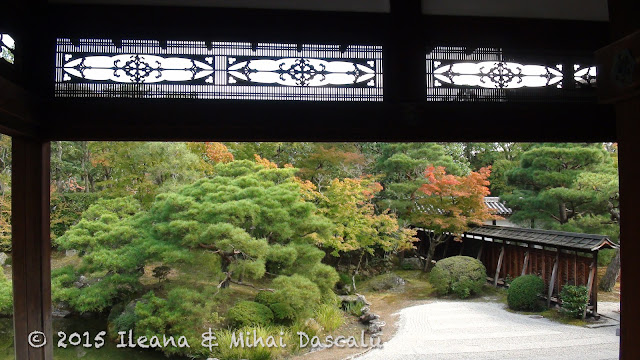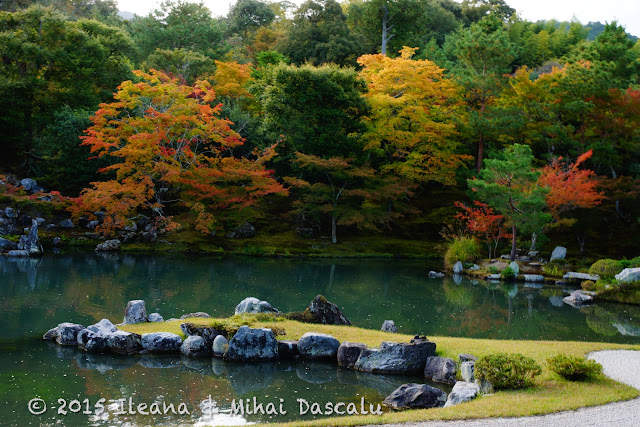October 27, 2015
Google challenges us: we have managed to transport ourselves by subway and buses, but can we take a bus without a number and no recognizable signs? Proud to say: Yes, we can, and even have seats.
We start with the best: Ryoan-ji. It is early in the morning, so there are just a few people admiring its rock garden: fifteen dark grey, odd-shaped rocks in a sea of white gravel. They say it resembles a tiger crossing a mountain stream with its cub.
But what I like is the wall made of clay boiled in oil.
The tea room, which opens to the rock garden, has painted fusuma all over. It is called Zoroku (six-zo), Tortoise, with six standing for head, tail and four legs. The tortoise is a symbol of the guardian god of the North, and that explains the drawings on the sliding doors.
There is a wash basin for the tea room on which it’s written “I learn only to be contended”. We exit through another garden, in which there are trees like in Dr. Seuss’s Lorax and persimmons, which I have to be content only to look at.
But what I like is the wall made of clay boiled in oil.
The tea room, which opens to the rock garden, has painted fusuma all over. It is called Zoroku (six-zo), Tortoise, with six standing for head, tail and four legs. The tortoise is a symbol of the guardian god of the North, and that explains the drawings on the sliding doors.
There is a wash basin for the tea room on which it’s written “I learn only to be contended”. We exit through another garden, in which there are trees like in Dr. Seuss’s Lorax and persimmons, which I have to be content only to look at.
A taxi takes us to the Kinkaku-ji temple, the Golden Pavilion, another World Heritage Site. Before entering the main garden, there is a moss one, in which different types of moss delineate islands around trees.
We learn that the Pavilion, with its three floors each a different style, is a shariden, containing the relics of Buddha. Maybe that is the explanation of the organized mob that surrounds the peaceful pond. We have to stay in line to take unhindered pictures.
It is a little better on the garden path, quieter, more personal space, but the behavior stays, we’re all trigger happy: carp fountain, check, beautiful view, check, people working in the garden, check, check, check…
We learn that the Pavilion, with its three floors each a different style, is a shariden, containing the relics of Buddha. Maybe that is the explanation of the organized mob that surrounds the peaceful pond. We have to stay in line to take unhindered pictures.
It is a little better on the garden path, quieter, more personal space, but the behavior stays, we’re all trigger happy: carp fountain, check, beautiful view, check, people working in the garden, check, check, check…
Ninna-ji, WHS, has a quiet beauty. A succession of linked buildings hems the gardens. We enjoy the painted fusuma (sliding doors) and an exhibition of treasures, including sutras brought from China by Kōbō Daishi (the founder of the Shingon Esoteric Buddhism). This is the only temple where they were using a leaf-blower, instead of a bamboo rake and it felt so un-Japanese.
Tenryū-ji, WHS, is unchanged. The hummingbird moths (named because they hover like their name-sake and because they are aproximately the same size) are still fluttering around flowering bushes and Japanese gentiane. We just stroll happily enjoying the surroundings, there is not much room in our heads for the information that makes so special this place.
We head home through the bamboo forest. It is a photo opportunity for everyone, tourist and locals alike. The tall bamboos fight for light-rights somewhere above us, leaving just a green-gray penumbra to filter onto us. The wind rushes, leaves rustle, trunks crackle dry and move in unison.
Do you remember Yūka? We’ve met in a train station after we visited Shirakawa-go. We’ve kept messaging forth and back and tonight we are going to visit her.
On the table the bentos reveal a true feast.
We exchange information about our past experiences, future plans. We learn that there is more in a Japanese name than the sound that it makes, how it is written can express different things: Laura ( a Romanian name that comes from the Latin “laurel” that was used to make wreaths for the champions) means “beautiful Romania”.
We have a wonderful evening!
 |
| Exiting the train station there is an exhibition of materials for kimonos. |
On the table the bentos reveal a true feast.
 |
| The mum is edible, a little bit on the hot side. |
We exchange information about our past experiences, future plans. We learn that there is more in a Japanese name than the sound that it makes, how it is written can express different things: Laura ( a Romanian name that comes from the Latin “laurel” that was used to make wreaths for the champions) means “beautiful Romania”.
We have a wonderful evening!
 |
| Two suns in a clouded sky? No, two yens floating on a mirroring water. |





































No comments:
Post a Comment
Comment form message here